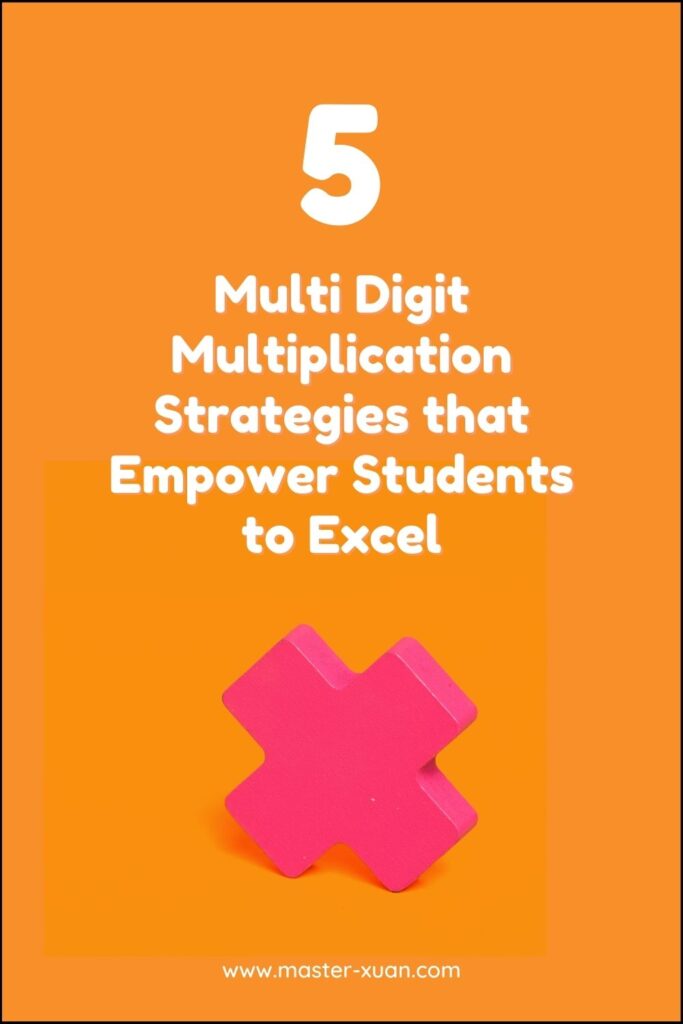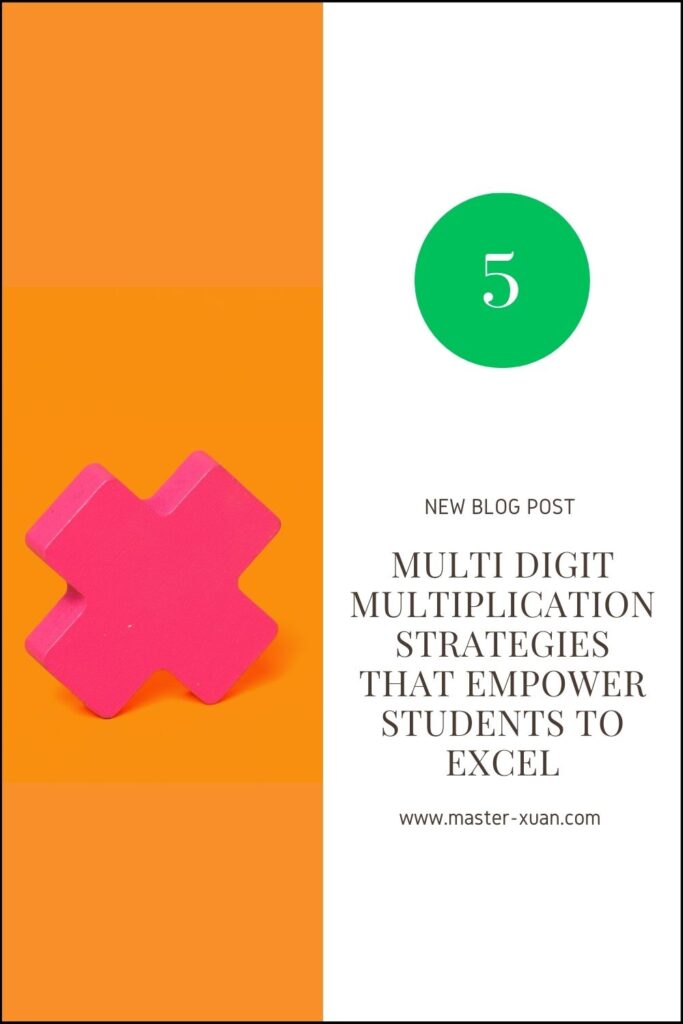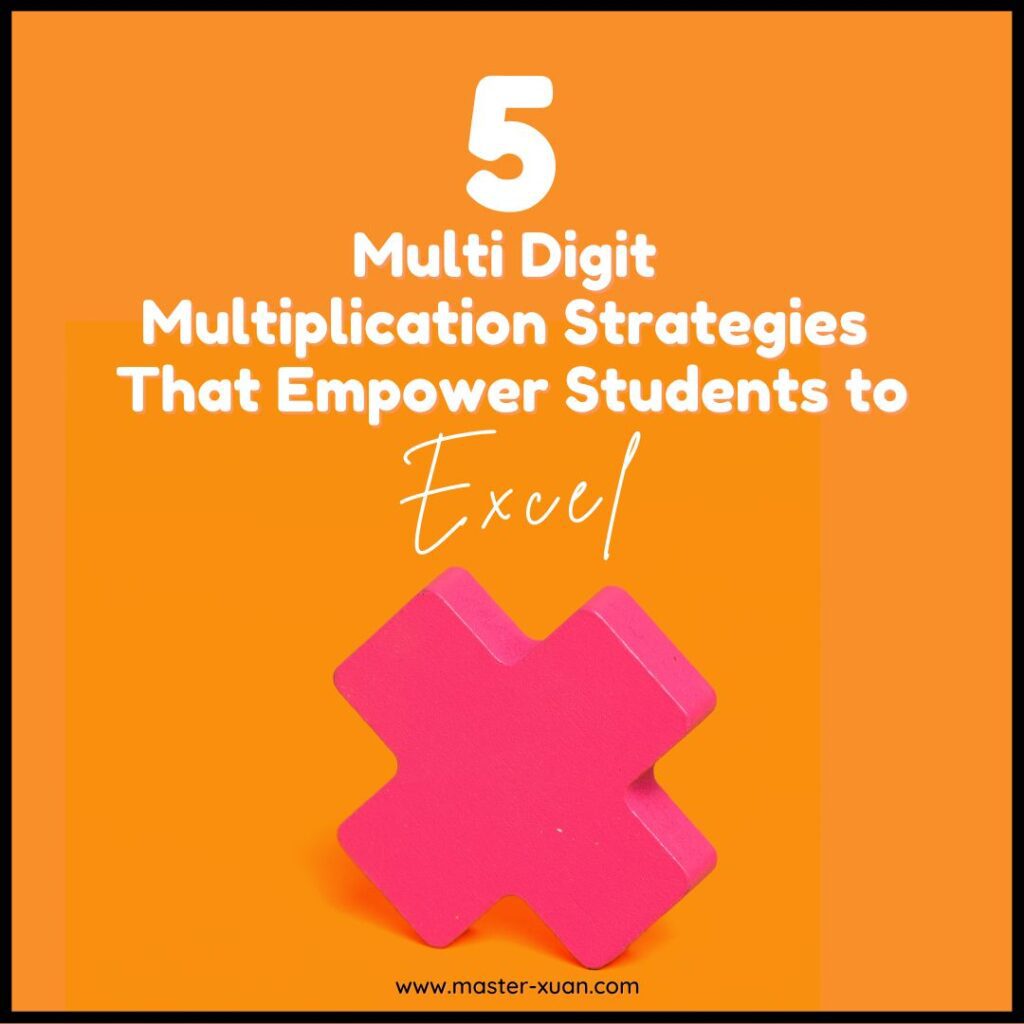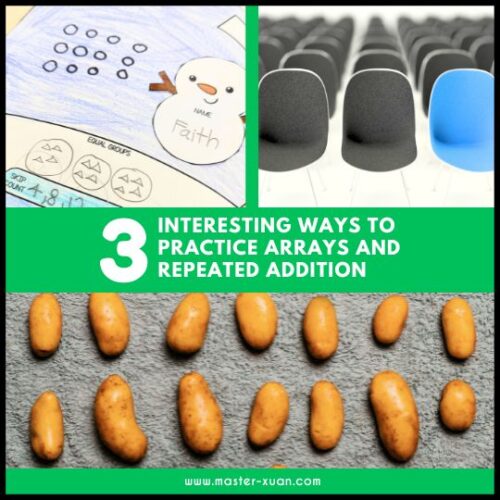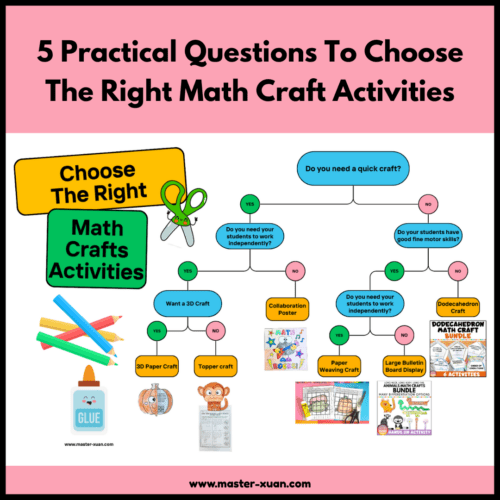Do you want to know the various multi digit multiplication strategies? Then you would want to continue to read on!
Multiplication is an essential skill that students need to learn in order to succeed in math.
Learning how to multiply numbers greater than 1 digit is the next step after students master their math facts.
While traditional methods like the standard algorithm are effective, there are other strategies that can be used to help students develop a deeper understanding of multiplication of multi-digit numbers.
In this blog post, we will explore some of the most effective multi digit multiplication strategies for students.
But before that, let’s discuss the importance of this math skill.
The Importance Of Learning Multi Digit Multiplication Strategies
Learning multi-digit multiplication strategies is crucial for several reasons.
Firstly, it is a fundamental skill that allows individuals to solve complex mathematical problems that involve large numbers.
It forms the backbone of many mathematical concepts, including algebra and calculus. A strong understanding of multi-digit multiplication is essential to build a solid foundation for learning these advanced math topics.
Secondly, multi-digit multiplication is used in various fields, including finance, science, and engineering.
For example, it is used to calculate sales tax, interest rates, and discounts in financial transactions. In science and engineering, multi-digit multiplication is used to make calculations involving quantities, measurements, and dimensions.
Thirdly, multi-digit multiplication provides individuals with valuable problem-solving skills that can be applied in everyday life.
It helps to develop logical and analytical thinking, which are essential skills in many fields. By mastering multi-digit multiplication strategies, individuals can quickly solve mathematical problems and make informed decisions in various situations.
Moreover, learning multi-digit multiplication strategies can boost one’s confidence in math.
Many people find math intimidating, but by mastering this skill, individuals can develop a positive attitude towards math and feel more confident in their abilities.
In conclusion, learning multi-digit multiplication strategies is essential for anyone seeking to excel in mathematics and related fields.
It provides a strong foundation for advanced math concepts, develops problem-solving skills, and has practical applications in everyday life.
1) Standard Algorithm / Long Multiplication
The standard algorithm is the traditional method for solving multi-digit multiplication problems.
It is sometimes referred to as the “long multiplication method.”
This algorithm involves lining up the two numbers (usually the larger number is stacked on top) to be multiplied, multiplying each digit of the second number by the digits of the first number from right to left, and then adding up the resulting products to obtain the final product.
Here’s a breakdown:
Step 1:
Align the numbers on the right so that their place values are aligned. Stack them on top of each other.
Step 2:
Multiply the bottom number in the ones place by the top number in the ones place.
If the product is a two-digit number, write the ones digit below the line and carry over the tens digit to the next column.
Step 3:
Multiply the bottom number in the ones place by the top number in the tens place.
Add the carried over number (if any) to the product.
Step 4:
Add a 0 in the ones place.
Multiply the top numbers by the tens place of the bottom number.
Step 5:
Add the 2 numbers to get the answer.
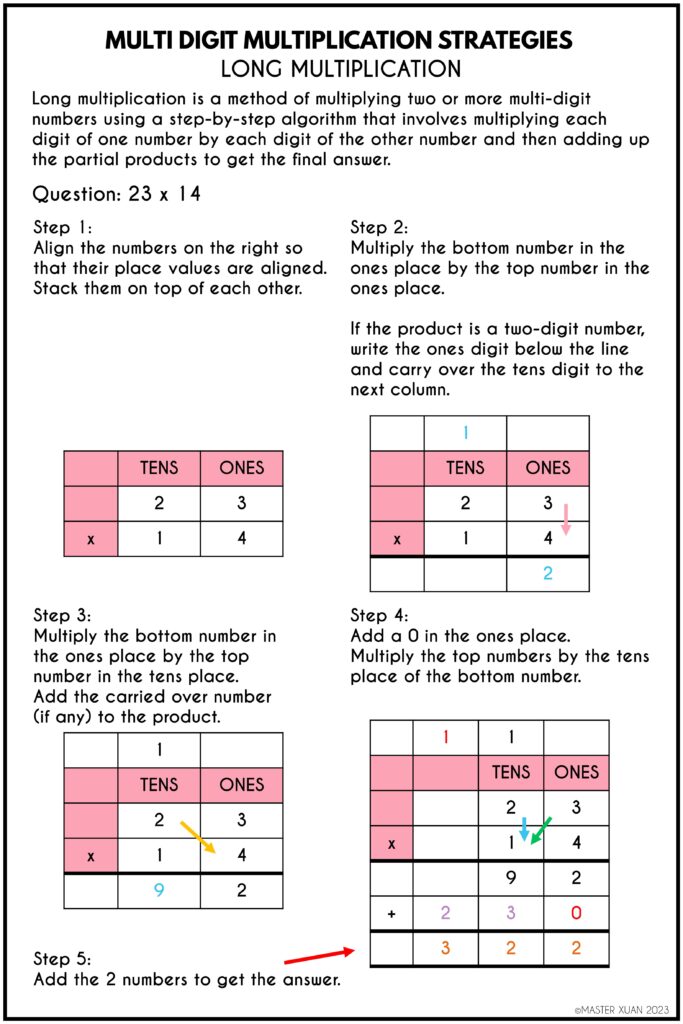
This method is the common strategy that we are taught when we are young and now passing it on to the new generation.
While it’s a reliable method, some students may find this method to be challenging or confusing.
You can make it easier by using tables, graph paper or lined paper. This helps to keep your columns and rows straight, and prevent errors.
2) Area Model
The area model is a method of multiplication that uses pictures of boxes or squares to help us see how the numbers we’re multiplying are related to each other. We draw the boxes or squares to represent the numbers, and then we count up how many squares there are to find the answer.
Step 1:
Draw the length and breadth of an array.
Step 2:
Next, complete the array.
Step 3:
Finally, add up all of the squares to get the answer.
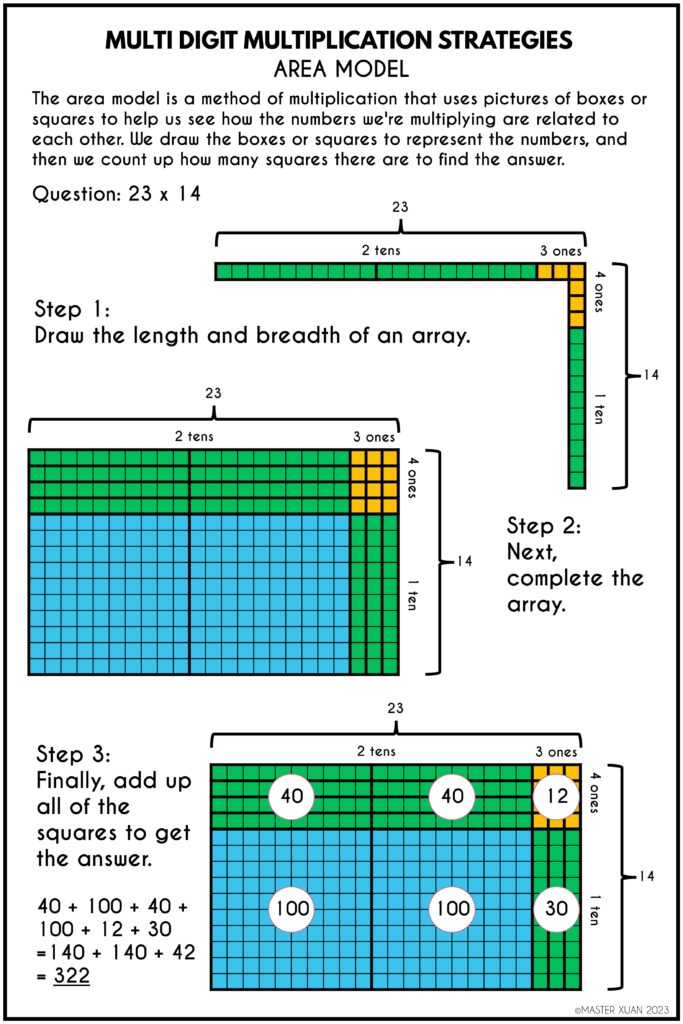
So we can use the manipulatives base-ten blocks to form an array. This is useful to help students develop conceptual understanding.
Step 1:
Place the base ten blocks to form the length and breadth of an array.
Step 2:
Next, use base ten blocks to fill in the array.
Step 3:
Finally, add up all of the blocks to get the answer.
3) Box Model Method
The box method helps shift students from the concrete stage to the semi-concrete or representational stage by replacing physical manipulatives with drawing models.
It is a variation of the area model (some also refer to this method as area model) that involves drawing a box and then dividing it into sections. Each section represents a different place value, and the numbers in each section are multiplied and added to get the final answer.
Step 1:
Draw your box based on the number of digits in each number.
Write both of your numbers in expanded form outside of the box.
Step 2:
Multiply the numbers that correspond to each row and column in the box.
Step 3:
Add the numbers in each column then add the sum to get the answer.
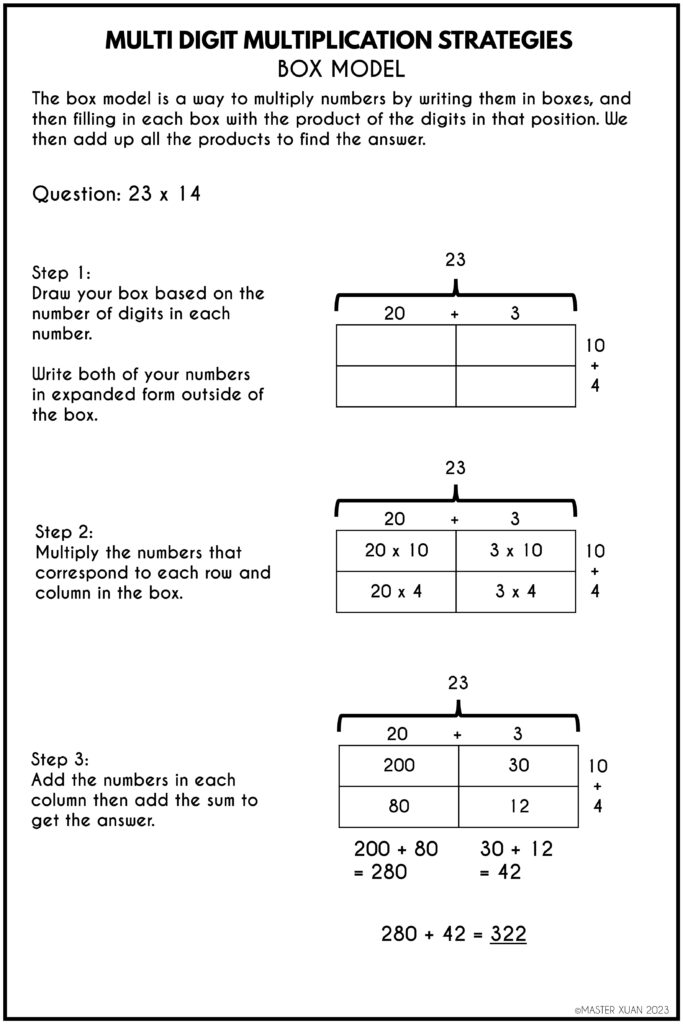
Here’s the comparison between area model and box model method.
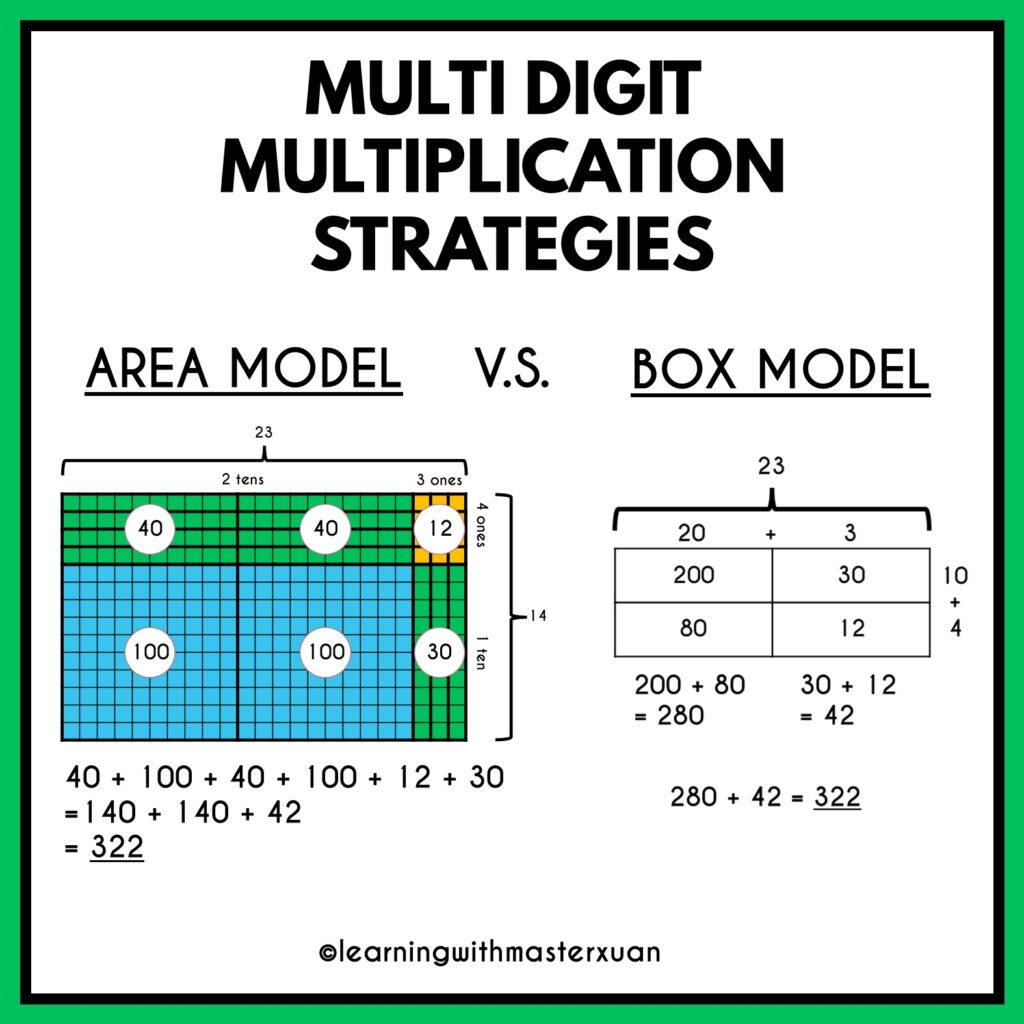
4) Partial Products Method / Distributive Property
The partial products method involves breaking down a multi-digit number into an expanded form and multiplying them separately. The final product is the sum of all the partial products.
This method can be great for mental math calculation.
Step 1:
Write the numbers into an expanded form.
Step 2:
Multiply the numbers and list their products.
Start by multiplying the digits in the ones place, then the digits in the tens place, and so on.
Step 3:
Add the partial products to get the answer.
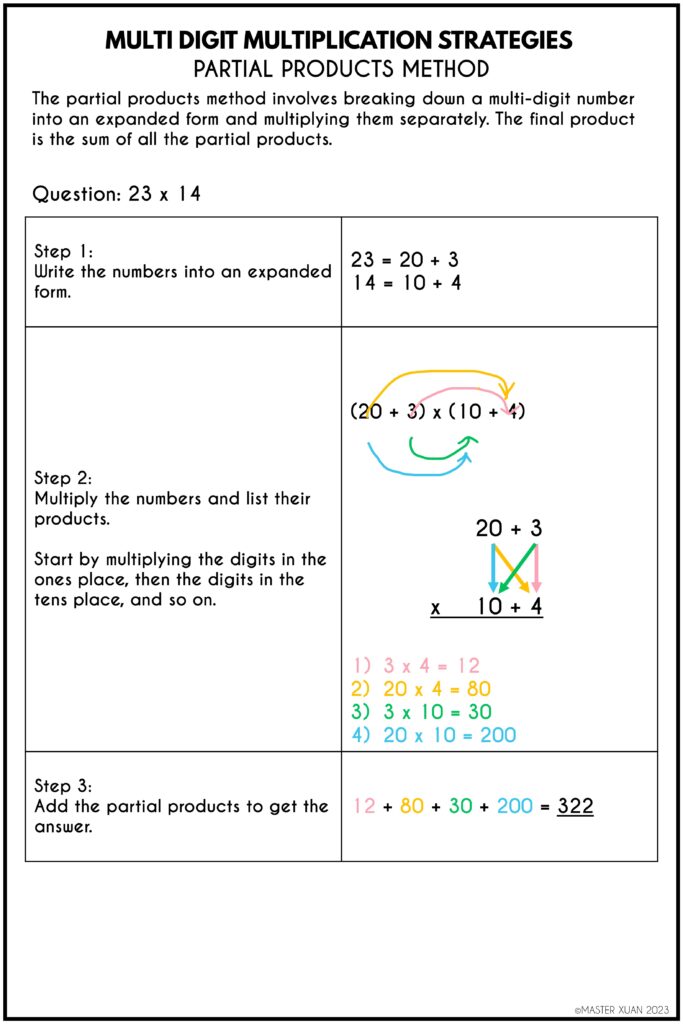
5) Lattice Method
The lattice method is a visual strategy that involves drawing a grid and multiplying the single digits in each place value. The final product is the sum of the numbers along the diagonals.
Teach this if other methods fail.
Step 1:
Draw a grid with the number of rows and columns that match the number of digits in the factors.
Step 2:
Write the digit along the top and right side of the grid.
Step 3:
Divide each box in the grid diagonally into two parts.
Write the product of the digits from the top and the right side of the grid in each box of the grid, and place the tens digit in the top-right part of the box and the ones digit in the bottom-left part of the box.
Step 4:
Add the numbers, starting from the bottom-right box.
Add the numbers in the bottom-left and top-right triangles of each box and carry over any extra digits to the next diagonal box to the left.
Then write the sum of each diagonal row along the left side and bottom of the grid.
Step 5:
Read the answer downwards from the top-left, then from left to right from the bottom-left.
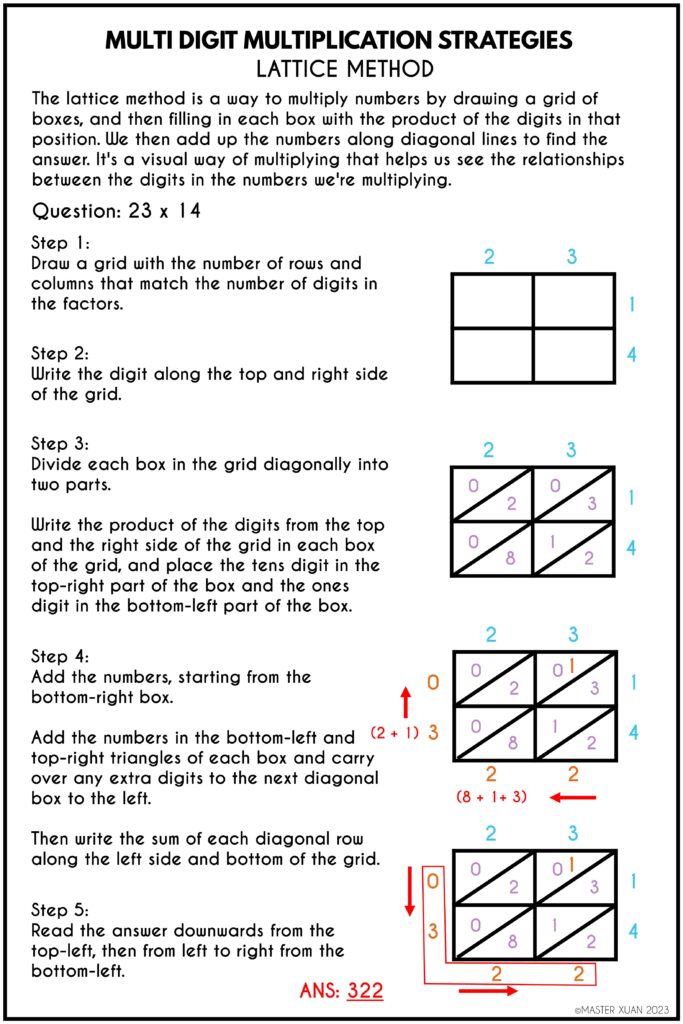
Tips for teaching multi digit multiplication strategies
Here are 3 different ways to make learning these strategies easier.
1) Anchor Charts
Anchor charts are a great way to help students remember multiplication strategies. You can create anchor charts for each strategy and display them in the classroom for easy reference.
Or you can use the posters in this blog post and use them as anchor charts for your classroom.
Here’s how:
- Right-click on the image and select “Save Image As” or “Save Picture As” (depending on your browser).
- Choose a location on your computer where you want to save the image, and give it a descriptive name that will help you remember what it is.
- Click “Save” to save the image to your computer.
- Print it and use it!
Do tag me (@learningwithmasterxuan) if you post on Instagram. You can also save these strategies to your Pinterest board so you can refer back or show it to your students later.
2) Games
You can use games to make the practice fun and enjoyable. Students will also tend to be more focused and calculate faster when playing.
This NO PREP 3 Digit By 2 Digit Multiplication Games has 12 independent math games that students can play on their own without needing to compete with their classmates.
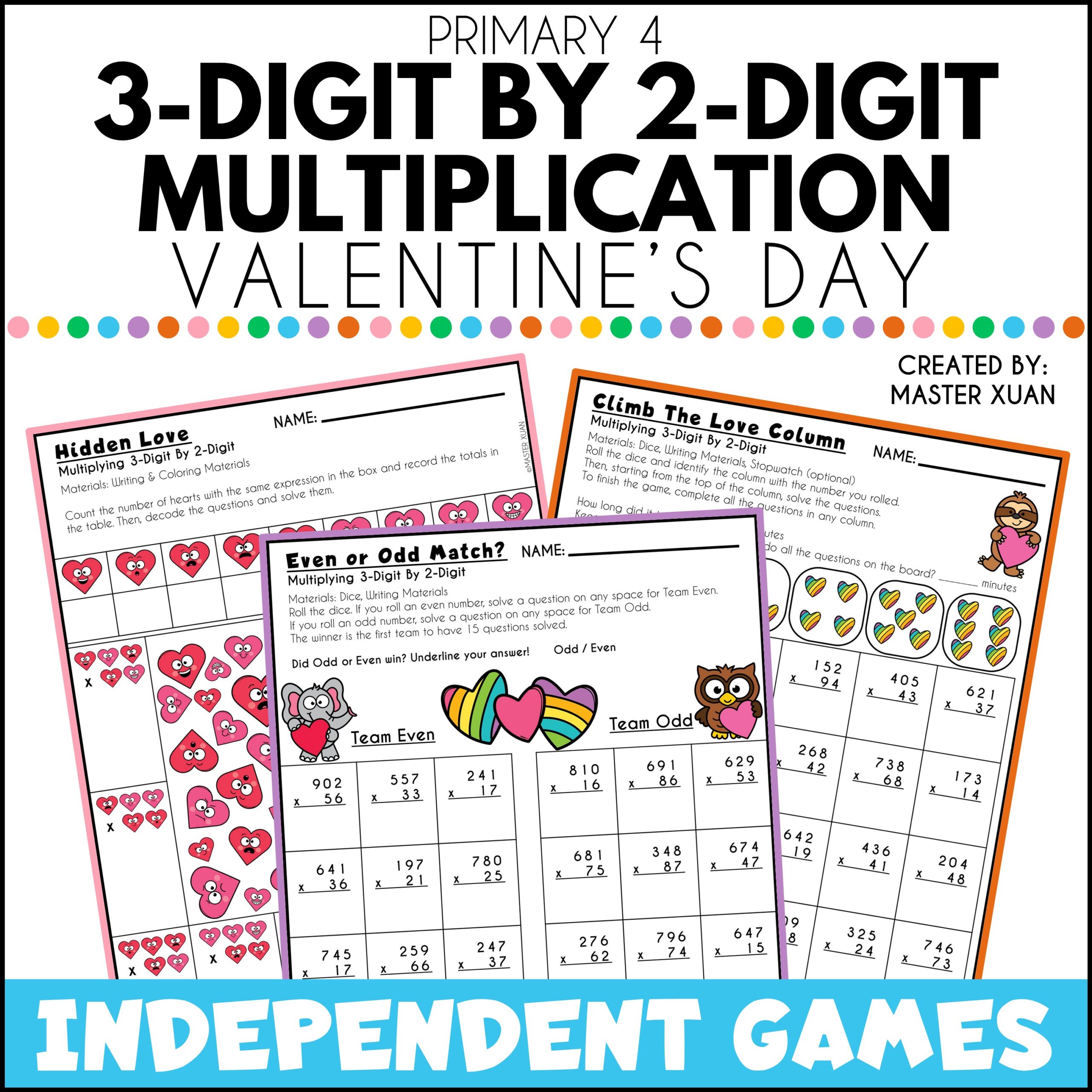
This is especially useful for students who prefer to work on their own, or who need some quiet time to focus on their math skills.
Answer keys are provided so it is easy for you to check and mark them.
They are great for substitutes, early finishers, math centers and as homework. Get them for your 4th/5th Graders or Primary 4 students!
3) Digital Task Cards – Boom Cards
Marking tens to thousands of practice drills can be tiring, but you can simplify the process by using self-checking digital task cards such as Boom cards.
With Boom cards, students not only receive instant feedback, but they can also enjoy the interactive features that make learning fun.
If you don’t have a Boom Learning account, now is the time! New users will receive a 10% discount on individual subscriptions with this link.
Remember to check out the various digital task cards in my Boom store!
Disclaimer: I may earn a referral prize when you use my discount at no additional cost from you.
If you’re looking for a digital practice that requires no preparation, try out Multiplying 3 digits by 1 digit. It’s similar to a math choice board or “Choose Your Own Adventure” and includes 56 Boom™ Cards.
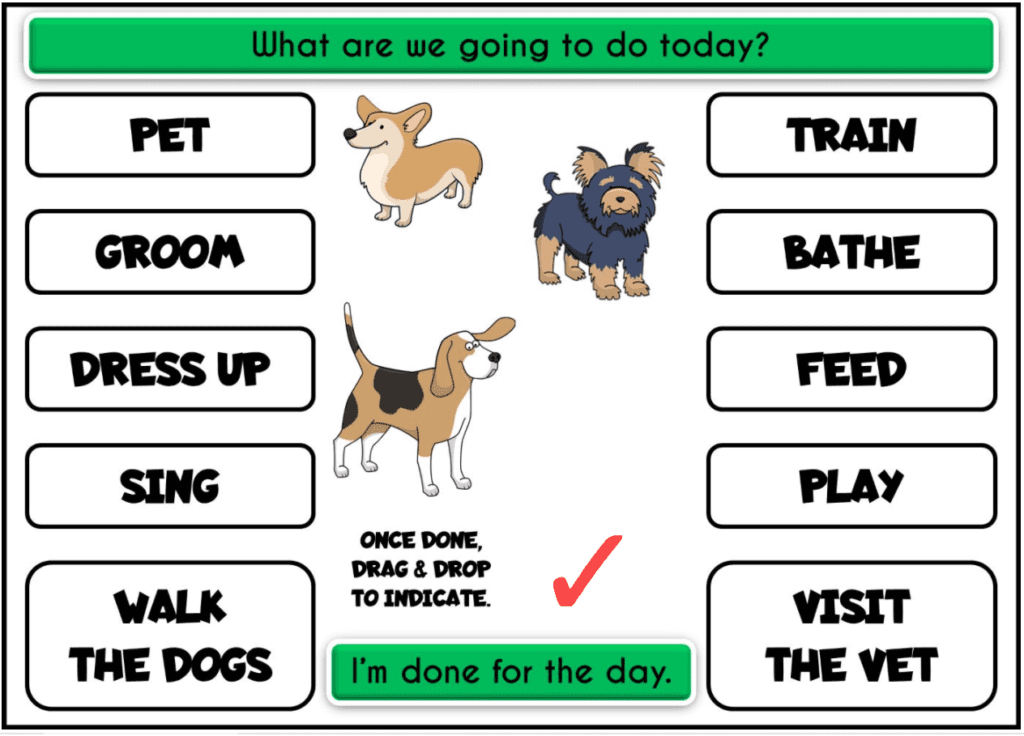
In total, there are 115 questions (including short answer questions and word problems), 10 main choices, and several sub-choices!
Students can play independently or in pairs, and the game can take over an hour to complete.
If you prefer, you can choose to play this deck in multiple sessions.
This dog-themed deck is perfect for dog lovers and aligns with National Pet Day.
Related Read: 3 Ways To Make Multiplication 3 Digits By 1 Digit Fun and Interesting
Final Thoughts
In conclusion, there are a variety of strategies that can be used to solve multi-digit multiplication problems. It’s important to use a combination of concrete methods and visual models to ensure that students have a deep understanding of place value and multiplication.
With the help of these strategies, students can develop a strong foundation in multiplication that will serve them well throughout their math education.
Overall, the choice of multiplication strategy may depend on personal preference or the specific needs of the student.
Some students may find one strategy more intuitive or easier to use than others.
It can be helpful for students to learn multiple strategies and experiment with different approaches to find the one that works best for them.
Here are some pins that you can save to bookmark this post. Save them to your Pinterest Board now! ↓
